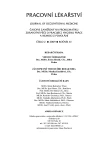Atopy in patients with allergic contact dermatitis
Authors:
Z. Hajduková 1; Y. Vantuchová 2; P. Klimková 1; M. Makhoul 2; R. Hromádková 2
Authors‘ workplace:
Klinika pracovního a preventivního lékařství FN Ostrava, přednosta MUDr. Zdeňka Hajduková, Ph. D.
1; Kožní oddělení FN Ostrava, primář MUDr. Yveta Vantuchová, Ph. D.
2
Published in:
Pracov. Lék., 61, 2009, No. 2, s. 69-73.
Category:
Original Papers
Overview
Background:
This study investigates prevalence of atopy in patients with allergic contact dermatitis (ACD), who were examined at the Ostrava Teaching Hospital in order to assess the impact of professional environment.
Objective:
To find out prevalence of atopy in patients with ACD and to investigate whether atopy is a risk factor for development of ACD.
Methods:
In the cross-sectional study, we studied the frequency distribution of atopy (presence of specific IgE antibodies in response to common inhalation allergens in blood by a Phadiatop test) in patients with ACD (n = 213, mean age 47 years, SD = 13 years ) and subjects of a control group (n = 938, mean age 38 years, SD = 11 years), who were recruited from individuals who had never been exposed to dust and known professional allergens in their occupational environment. All subjects (n = 1 151) were examined by the physician at the clinic.
Results:
There were 34 % patients with atopy in the group of patients with ACD and 32 % individuals with atopy in the control group. No statistically significant differences between patients with ACD and controls were found. Also no statistically significant differences bet- ween women and men were found. Only four patients with ACD had atopic dermatitis.
Conclusion:
Atopy is not a risk factor for ACD.
Key words:
atopy, allergic contact dermatitis, occupational skin diseases
Sources
1. BRYLD, L. E., HINDSBERGER, CH., KYVIK, K. O., AGNER, Z. T., MENNE, T. Genetic Factors in Nickel Allergy Evaluated in a Population-Based Female Twin Sample. J. Invest. Dermatol., 2004, 123, s. 1025–1029.
2. BUCKLEY, D. A., BASKETTER, D. A., KAN-KING-YU, D., WHITE, I. R., WHITE, J. L., MCFADDEN, J. P. Atopy and contact allergy to fragrance: allergic reactions to the fragrance mix I (the Larsen mix). Contact Dermatitis, 2008, 59, s. 220–225.
3. ČAPKOVÁ, Š. Diferenciální diagnóza atopické dermatitidy v kojeneckém a batolecím věku. Alergie, 2006, 8, s. 210–212.
4. ELLIS, C., LUGER, T., LUGER, T., ABECK, D. et al. International Konsensus Konference on Atopic Dermatitis (ICCAD II): clinical update and current treatment strategie. Brit. J. Dermatol., 2003, 148, Suppl 63, s. 3-10.
5. GINA 2008. Dostupné na: www.ginasthma.org.
6. HARPER, J., ORANJE, A., PROSE, N. Textbook of Pediatric Dermatology. Second Edition. Město: Blackwell Publishing 2006, 2, 251 s.
7. CHEE-CHING SUN, YUE-LIANG GUO, RUEY-SHIUNG LAIN Occupational hand dermatitis in a tertiary referral dermatology clinic in Taipei. Contact Dermatitis, 1995, 33, s. 414–418.
8. JACOB, S. E., STEELE, T. Allergic Contact Dermatitis: Early Recognition and Diagnosis of Important Allergens. Dermatology nursing, 2006, 18, 5, s. 433–446.
9. KLAS, P. A., COREY, G., STORRS, F. J., CHAN, S. C., HANFIN, J. M. Allergic and irritant patch test reactions and atopic disease. Contact Dermatitis, 1996, 34, s. 121–124.
10. MAUER, D., EGNER, C., REININGER, B., FIEBIGER, E., KRAFT, D., KONET, J. P. et al. The high afinity IgE receptor mediates IgE-dependent allergen presentation. J. Immunol., 1995, 154, s. 6385–6290.
11. MORTZ, C. G., LAURITSEN, J. M., BINDSLEV-JENSENM C., ANDERSEN, K. E. Prevalence of atopic dermatitis, asthma, allergic rhinitis, and hand and contact dermatitis in adolescents. The Odense Adolescence Cohort Study on Atopic Diseases and Dermatitis. Brit. J. Dermatol., 2001, 144, s. 523–532.
12. NANCY, L., SPRINCE, J., PALMER, A., POPENDORF, W., THORNE, P. S., MUSTAFA, I. S., ZWERLING, C., MILLER, E. R. Dermatitis among automobile production machine operators exposed to metal-working fluids. Am. J. Indust. Med., 1998, 118, 30, s. 421–429.
13. NETTIS, E., COLANARDI, M. C., SOCCIO, A. L., FERRANNINI, A., TURSI, A. Occupational irritant and allergic contact dermatitis among healthcare workers. Contact Dermatitis, 2002, 46, s. 101–107.
14. SAGER, N., FELDMANN, A., SCHILLING, G., KREITSCH, P., NEUMANN, C. House dust mte-specific T cells in the skin of subjects with atopic dermatitis: frequency and lymphokine profile in the allergen test. J. Allergy Clin. Immunol., 1992, 89, s. 801–810.
15. SARTORELLI, P., CARBONCINI, F., MURDACA, F., NOVELLI, M. T., ORSI, D., MANCINI, R. Contact sensitization in fruit farmers. J. Environ. Med., 1999, 1, s. 51–53.
16. SWAEN, G. M. H. et al. Occupational exposure to ethyl-enebisdithiocarbamates in agriculture and allergy: results from the EUROPIT field study. Human & Experimental Toxicology, 2008, 27, s. 715–720.
17. ŠPIČÁK, V. EAACI – Definice v alergologii. Alergie, 2004, 6, s. 129.
18. VAN KAMPEN, V., MERGET, R., BAUR, X. Occupational airway sensitizers: an overview on the respective literature. Am. J. Ind. Med., 2000, 38, s. 164–218.
19. VAN REIJSEN, F. C., BRUIJNZEEL-KOOMEN, C. A. F.M., KALTHOFF, F. S., MAGGI, E., ROMAGNANI, S., WESTLAND, J. K. T. et al. Skin-derived aeroallergen--specific T-cell clones of TH2 phenotype in patients with atopic dermatitis. J. Allergy Clin. Immunol., 1992, 90, s. 184–192.
20. VEIEN, N. K., HATTEL, T., LAURBERG, G. Hand eczema: causes, course, and prognosis. Contact Dermatitis, 2008, 58, s. 330–334.
Labels
Hygiene and epidemiology Hyperbaric medicine Occupational medicineArticle was published in
Occupational Medicine

2009 Issue 2
Most read in this issue
- Lyme borreliosis from the perspective of Occupational Medicine – a comparative study
- TBC nowadays
- Selected harmful substances in rubber-making technologies
- Atopy in patients with allergic contact dermatitis
